Roberts Market Place at Kingshighway & Delmar Hostile to Pedestrians
The Roberts Market Place has opened at Kingshighway & Delmar, the site of a former Schnucks. Discount grocer ALDI, the only business so far, is the anchor. Unfortunately, it is designed to be driven to, not walked to.
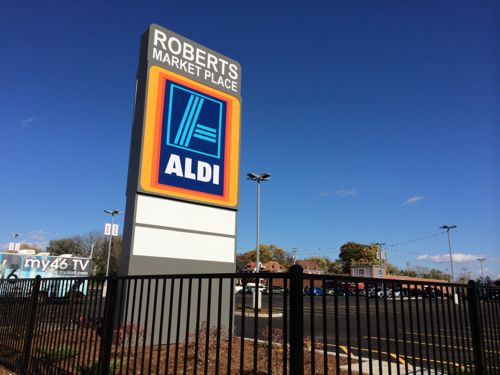
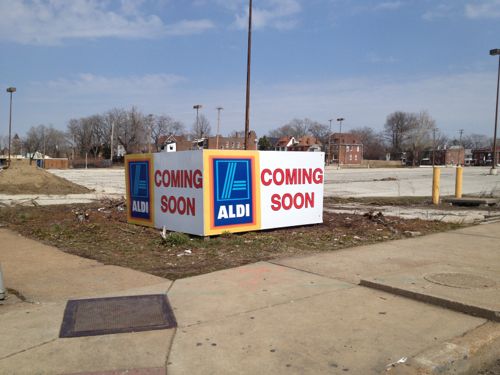
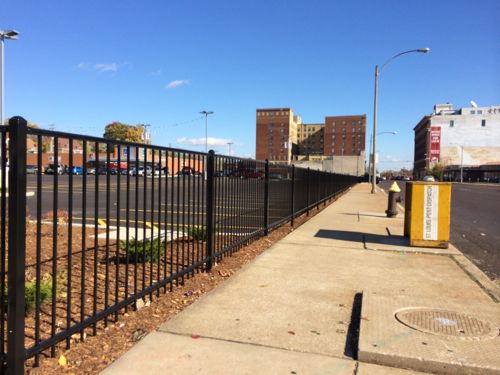
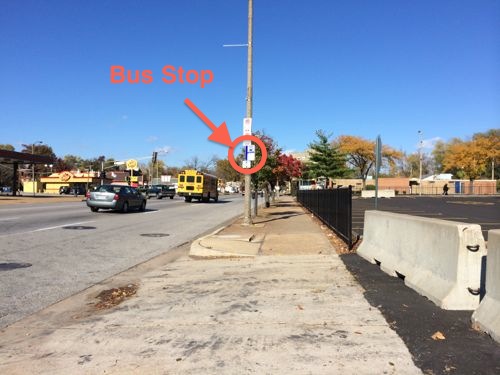
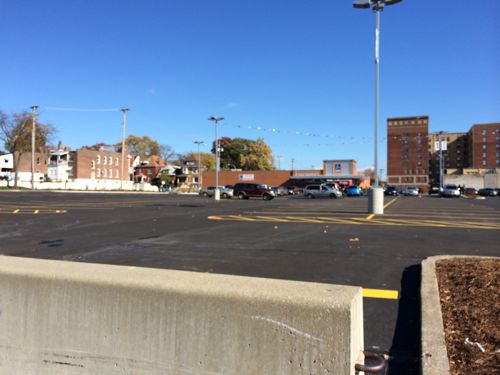
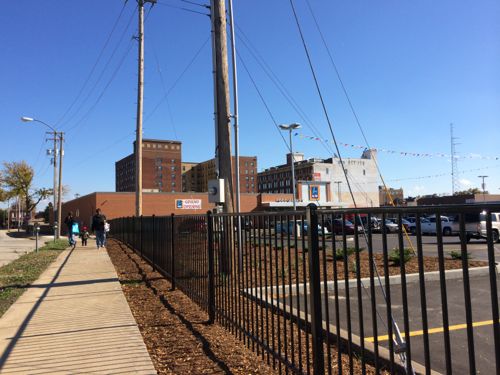
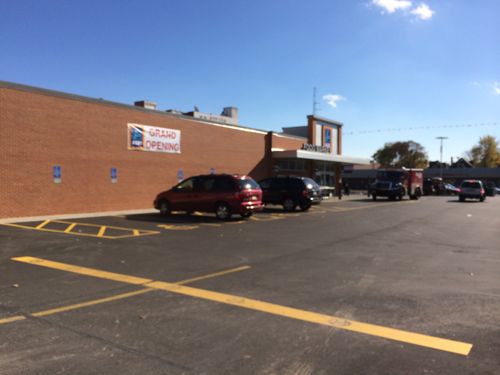
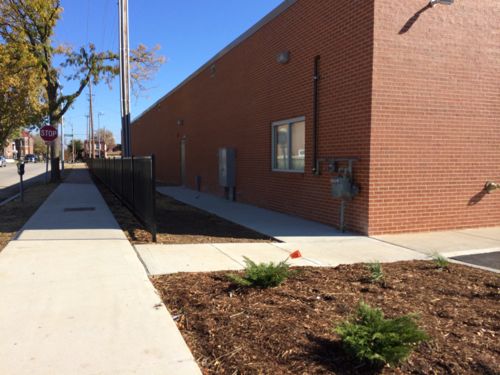
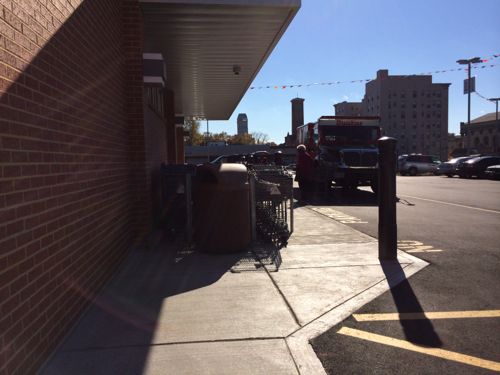
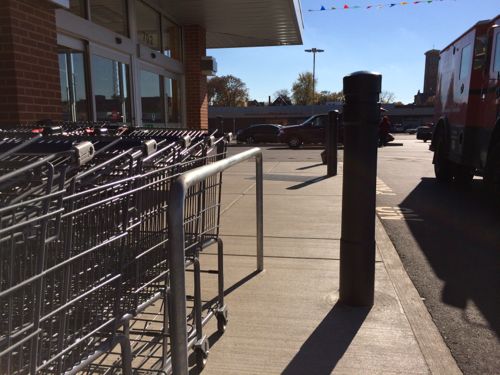
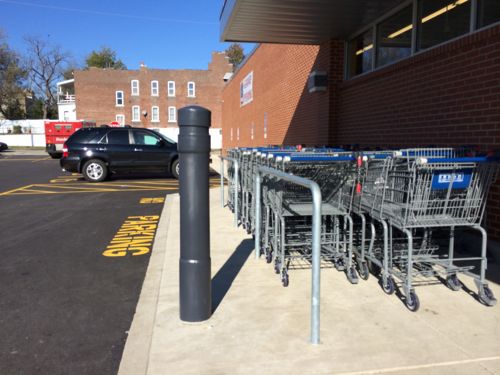
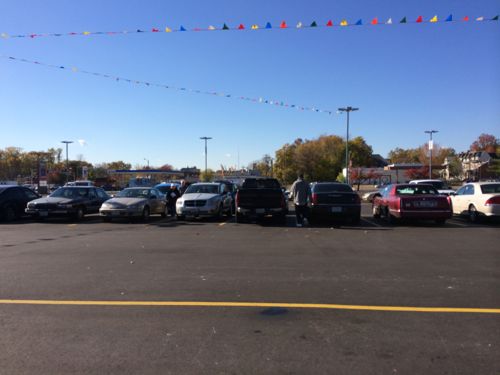
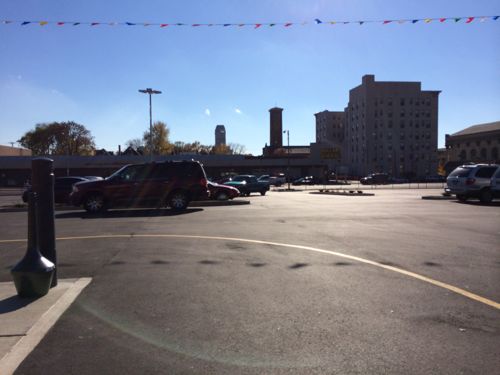
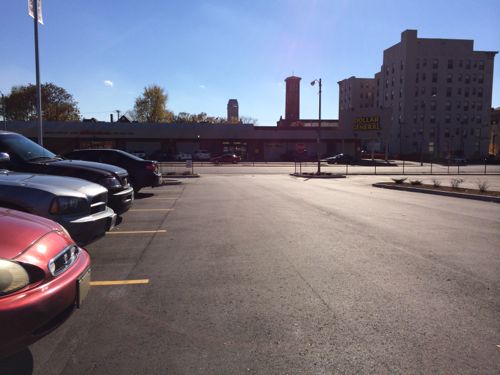
Seriously? The one minimal pedestrian route from a secondary road is blocked by a bollard!?! As I mentioned in April, the site has been divided into three parcels.
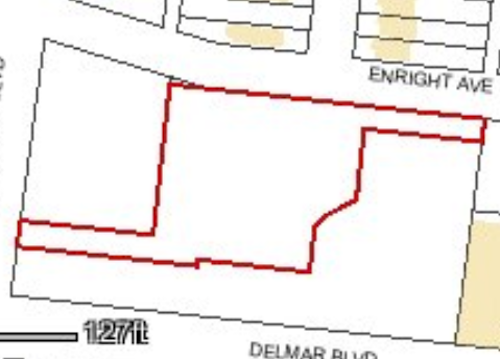
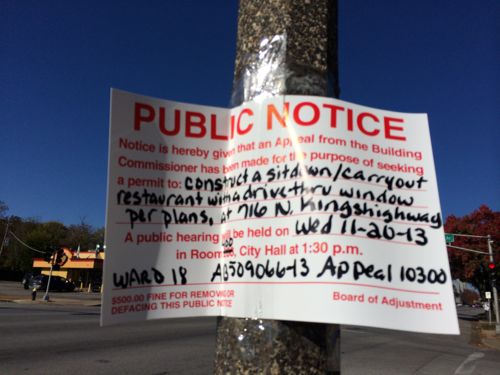
It would’ve been relatively easy to plan a north-south sidewalk through the site connecting Enright to Delmar, with a perpendicular walk connecting to the bus stop on Kingshighway. This would’ve provided a pedestrian route to all three adjacent streets and to all three parcels. Instead we’ve got another development that ignores pedestrians almost entirely.
The #97 (Delmar) bus and #95 (Kingshighway) bus generate lots of pedestrian traffic at this location. Many customers & employees of ALDI, a new drive-thru, and a third place will arrive on foot. Development in our neighborhoods should be designed to welcome motorists, bicyclists, and pedestrians. This must be mandated, developers aren’t going to do it on their own — especially not in low-income areas where they do as little as possible.
— Steve Patterson
Typical of development in the 17th Ward that fails to build upon the energy and mostly good development in the adjacent 28th ward. Lack of neighborhood input part of the problem and the city’s system of aldermanic fiefdoms. Rollen Stanley once told me the intersection of Kingshighway and Delmar was one of the higher household income areas in the city and this development fails to build on any of these assets as well as transit.
17th ward? This development is in the 18th ward and right next to the 28th. The 17th ward’s northern boundary is at Lindell.
You’re right Herbie. Thanks. Issue is the same, the site is a five minute walk from million dollar homes. The developer missed an opportunity in many ways.
So, sue ’em! You seem to think that you have pretty clear evidence of noncompliance with the ADA. This “nonsense” won’t end until people end up in court, not just being outed on your blog. But to play devil’s advocate, it appears that the concrete and the asphalt is at the same level / grade for the entire width of the entrance AND that the asphalt is striped and labeled to prohibit parking in front of Aldi. A smooth, continuous walking surface IS provided, it’s just not concrete for the entire width or distance (nor is it required to be). The downside to increased accessibility is fewer curbs and less definition between materials, but there are more options for easier access.
Moving on, a couple of observations / questions. One, the fence is obviously a new addition. Was it added to create a more urban feel / separate the surface parking from the public right of way? Or, was it added to protect the vehicles in the parking lot from vandalism and break-ins? If it’s there for “security”, adding openings for pedestrians defeats its intent. And two, how much new site work was done along Kingshighway and Delmar? It looks like the work along Enright is all new and much “better”. Could it be that when work is completed for “a new drive-thru and a third place” that the infrastructure along the two other streets will be replaced / improved, as well?
With 3 retail spaces in the development it is 2 shy of being a shopping center under the ADA. The solution is for the city to require walkable development!!
Bottom line: if people don’t feel safe, they sure as heck aren’t going to walk to it.
As I said in the post, this is a high pedestrian area currently.
So is the Schnucks on Lindell that has been fenced in for what….15 years?
Huge difference, that development isn’t perfect but it has numerous pedestrian entrances that doth require walking in the auto drives.
If it’s not a shopping center, each individual business has a responsibility to provide a separate accessible path of travel from the (a?) public sidewalk. If anything, a shopping center would makes things easier (for compliance), since a shared path of travel would be sufficient – I’m not sure that I get the point that you’re trying to make.
So, your “solution is for the city to require walkable development!!” How do we make that a reality? Convince the majority to put in more rules to benefit a distinct minority? I’m with you, I’d like “better”. ADA / ADAAG creates a minimum standard, other cities have varying standards, usually enforced by the Planning Dept., Public Works, or both. Private developers can and do create and enforce specific standards, as well. But most aldermen (and most residents) would rather see any development, now, than wait for something “better” later.
This is / was a vacant site in a struggling neighborhood – Schnuck’s couldn’t make it work, so anything coming in to replace it will not have a lot of funding for “frills”. Local residents will likely raise few concerns about “inadequate” infrastructure, whether driving or walking, and certainly won’t boycott Aldi because there’s something better / more attractive anywhere nearby. What argument(s) can / do we make that will “encourage” change? How do we define (and justify) a certain, better level of walkability? (And a pundit living in a loft downtown or a transplanted architect living in south city will only have a limited amount of credibility.) You’re right to say that “This must be mandated, developers aren’t going to do it on their own.” But what arguments will work HERE and in other struggling areas of the city?!
The ADA allow vehicular ways to be used for pedestrians, except for shopping centers. Elsewhere in the ADA a shopping center is defined a 5 or more businesses. I’m still clarifying if that same definition applies to accessible routes.
Regardless, the ALDI route is in violation of the ADA because the disabled must leave the route to pass.
One, so sue ’em. Two, there is nothing in the ADA / ADAAG that specifies “only concrete” (the definition is “a hard, walkable surface”), nor does it require an arrow-straight path of travel. Deviating the path of travel around the cart storage is NOT illegal. The only “failure” I see is that the pedestrian area outside the main entrance is delineated with only a single, painted, yellow stripe.
Would it be better if it were all concrete? Absolutely! Painted like the access aisles for the accessible parking spaces? Certainly. But a direct path of travel IS currently being provided from both the nearest public sidewalk (on Enright) and from the designated accessible parking spaces, appropriately located to the north of the front door. The path of travel does not require pedestrians to cross any vehicular aisles. It complies and it is safe.
Would it be better if the cart corral were shifted south and a 5′ wide, arrow-straight path were provided between the building and the corral? In theory, yes; in reality, no – carts will end up in the 5′ wide space as well as in the corral, negating the usability of the accessible path.
An accessible path isn’t provided from the nearest public transit stops. An ADA compaijt takes a lot of effort to succeed. In this case I could probably get them to move one bollard. Good urban planning won’t be accomplished in the court system.
Agree, good planning won’t be accomplished in the court system. Disagree that an accessible path is not provided from the nearest public transit stops. The path from the northbound stop on Kingshighway (as well as from the crosswalks serving the other 3 stops at this intersection) is north on Kingshighway, east on Enright, then south to the front door. (There does not appear to be a stop on the north side of Delmar east of Kingshighway; there is one on the west side.)
I get it. You “want” a path that goes directly from the corner, through the parking lot, straight to the front door. You also want it to be safe and well designed. What you really want is two separate parking lots, with a really nice sidewalk separating the two. Ain’t gonna happen. You’re either going to get the path that’s there now, utilizing the existing sidewalks on the public right of way or you’re going to get a sidewalk crossing multiple drive aisles in the larger parking lot. From a safety standpoint, especially for customers in wheelchairs, minimizing conflicts with vehicles provides more safety for all involved than providing a shorter, straighter path with more conflicts.
Funny. Just how do you think employment and the ADA laws were developed and fine tuned? this continues on to this day.
my initial thought was that it was stupid to put up a fence as a needless barrier to
people walking to the store. Then I thought that it might be to discourage people
breaking into cars. But on further reflection, such a person could easily jump the
fence. What do the developers, architects or city reviewers say is the reasoning?
Urban planners argue that screening surface parking lots with fencing and/or landscaping makes it more pleasant for pedestrians to walk by.
Yes, a fence is preferred to having the sidewalk fade into paving. But, openings in the fence should he provided for pedestrian — not just cars.
Fences are also installed to provide security / limit access. What’s unclear, here, is which issue is the priority.
Which is why no matter a builder puts down, if a customer deems it unsafe they will do these things: visit but by car, visit but only if there is a bus stop directly and closely to the development, and finally…just won’t visit. So minimally I’m willing to bet the fences are there to add a sense of security. Whether they actually provides security is immaterial.
This is where Sesame Street falls short. Let’s face it the Roberts Bros aren’t into aesthetics. If you look at their development up the street at Page and Kingshighway, you can see that in practice. There is a typical suburban, car orientated strip mall. With their flagship building, the old Sears, they did a decent job with it, but that was because it was already there. (although it has been a few years since I have been in the building).
Basically with the site on Delmar they just put back what was already there and didn’t even do a good job of that. It is certainly no more and probably even less pedestrian orientated than the original Schnucks, if that is possible. Are there missed opportunities at this site? I would say so, but capitalism today is not about risk and innovation.
We are at the point in our history when we need to start doing things differently. What is the governments role? Not sure, but there is clearly no overarching strategies or goals for the city. This while the government officials in the city go around make a big show about its sustainability concerns with public meetings and so on. Yet they never really doing anything of substance.
I guess when Florida is under water we’ll get serious then.
I moved on Delmar blvd about 13 years ago, as far as the fencing goes the city told us how our fencing had to be, sides and back could be wood, but the sides facing the street had to be wrought iron, the Lindell marketplace was not always fenced around, it came later, Schnuck’s just did not want to be in that area, for whatever their reasoning was because the store was always packed, and it was larger than the Lindell store. One thing I will say, as a resident of the area, I for one am glad to see something more than an empty lot, it is not perfect by any means, but something is there finally!